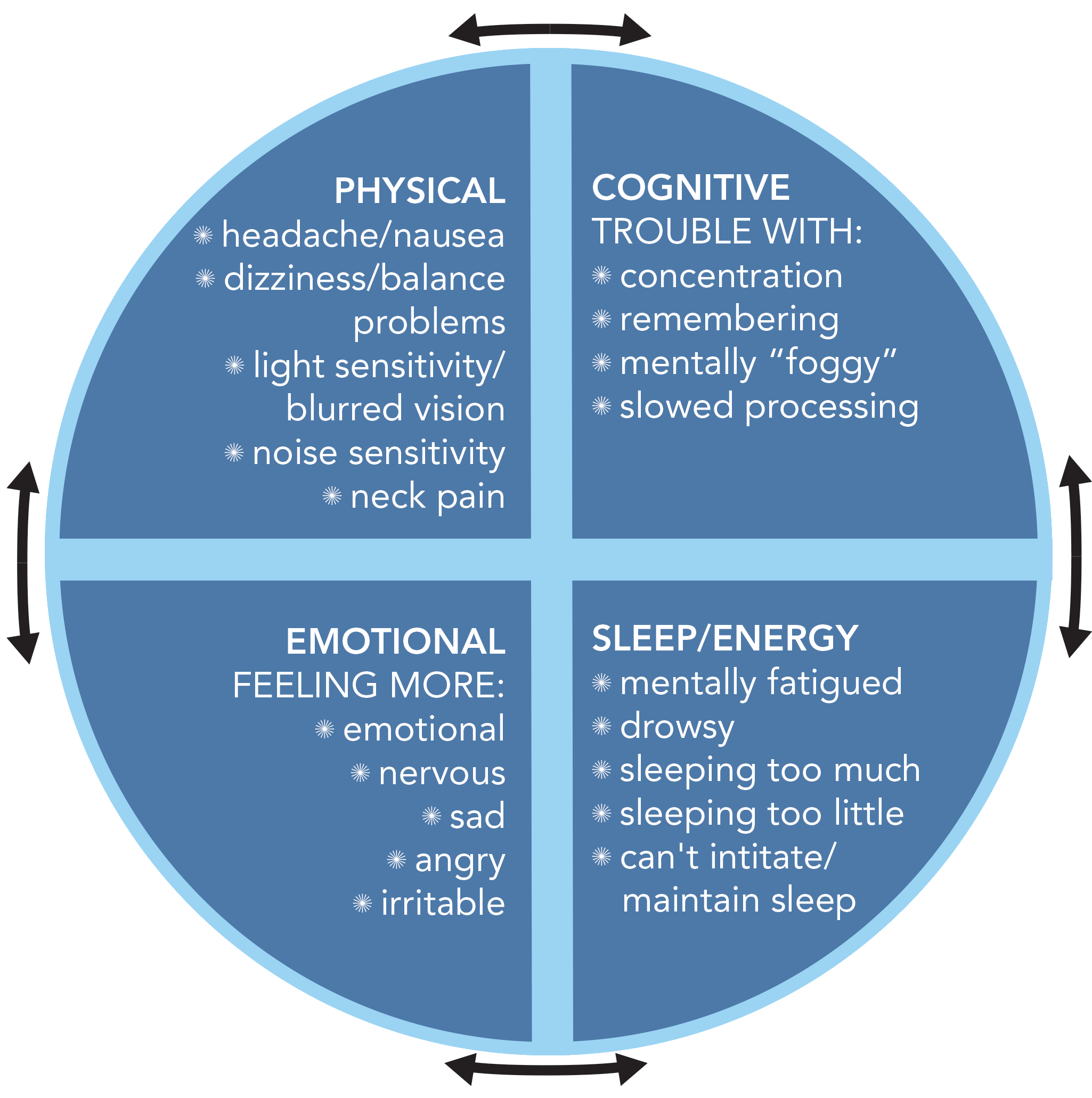STEP THREE: ADJUST/ACCOMMODATE for EDUCATORS (continued)
Typically, students’ symptoms only require a few days of absence from school. If more than a few days are missed, call a meeting with parents and seek a medical explanation.
Research shows that students who rested for a few days followed by a gradual return to activities (school, socializing) had fewer reported symptoms than students who took 5 days of strict rest.
More rest has not been proven to be the fastest, easiest way to recover from a concussion! A reasonable amount of rest, followed by a measured increase in home, academic and cardiovascular exercises (activities that do not overly exacerbate symptoms), seems to be the formula for better concussion recovery.
Symptom Wheel
Suggested Academic Adjustments
PHYSICAL:
- "Strategic Rest" proactive scheduled 15 to 20 minute breaks in clinic/quiet space (mid-morning, mid-afternoon, and/or as needed)
- Sunglasses (inside and outside)
- Quiet room/environment, quiet lunch, quiet recess
- More frequent breaks in classroom and/or in clinic
- Allow quiet passing in halls
- REMOVE from high risk physical activity in PE, recess, & dance class without penalty
- Sit out of music, orchestra and computer classes if symptoms are provoked
COGNITIVE:
- REDUCE workload in the classroom/homework
- REMOVE non-essential work
- REDUCE repetition of work (i.e. only do even problems, go for quality not quantity)
- Adjust due dates; allow for extra time
- Allow student to "audit" classwork (listen/learn without output demands)
- Exempt/postpone large tests/projects; alternative testing (quiet testing, one-on-one testing, oral testing)
- Allow demonstration of learning in alternative fashion
- Provide written instructions
- Allow for buddy notes or teacher notes, study guides, word banks
- Allow for technology (tape recorder, smart pen) if tolerated

Symptom Categories Diagram
Physical
Headache/nausea, dizziness/balance problems, light sensitivity/blurred vision, noise sensitivity, neck pain
Cognitive
Trouble with concentration, remembering, mental "foggy", slowed processing
Emotional
Feeling more emotional, nervous, sad, angry, irritable
Sleep/Energy
Mentally fatigued, drowsy, sleeping too much, sleeping too little, can't initiate/maintain sleep
EMOTIONAL:
- Allow student to have signal to leave room if symptoms are flaring
- Help staff understand that mental fatigue can manifest in "emotional meltdowns"
- Allow student to remove themself to de-escalate
- Allow student to visit with supportive adult (counselor, nurse, advisor)
- Watch for secondary symptoms of depression and anxiety usually due to social isolation and concern over "make-up work" and slipping grades. These extra emotional factors can delay recovery.
SLEEP/ENERGY:
- Allow for "Pacing" – 5 to 10 minute eye/brain/water rest breaks in the classroom (i.e. eyes closed, head on desk) after periods of mental exertion
- Alternate "mental challenge" with "mental rest"
Message to Educators
An inefficiently fueled brain (aka a concussed brain) leads primarily to:
- mental fatigue (aka a need for Symptom Management)
- slowed processing speed (aka a need for Workload Management)
- problems with short-term memory (aka difficulty learning new material otherwise known to educators as Mastery and Grades)
How do you deal with mental fatigue in your classroom already (perhaps due to mono or family stress)? You might offer more rest breaks or some extra tender loving care (TLC).
How do you deal with a student’s inability to get through in-class work due to slowed processing speed (perhaps due to ADHD)? If you teach math, you might assign every other problem. If you teach social studies, you might have the student listen with supplemental buddy notes.
What do you do if a student on chemotherapy has been physically or cognitively unavailable to learn and now is scheduled to take a test? You might offer them the option of an oral presentation.
You see, the key to supporting a student with a concussion is “differentiated instruction", a tool already within your repertoire! If you know how to help students with mental fatigue, slowed processing speed and short-term memory problems - secondary to any medical/psychological condition - then you know how to support students with a concussion.
The best academic adjustment you can offer a student with a concussion is: REMOVAL of non-essential in-class work/homework and a REDUCTION of semi-essential in-class work/homework.
Extension and postponement of work is not a helpful tool for a student who struggles with cognitive inefficiencies for weeks to months (whether that inefficiency comes from concussion, trauma or mono). With slowed processing speed, incomplete work will not be able to be made-up long after the fact -it must be removed and reduced. Focus only on a reasonable amount of current, essential work.
Adapted from GetSchooledOnConcussions.com/Teacher Acute Concussion Tool (TACT)